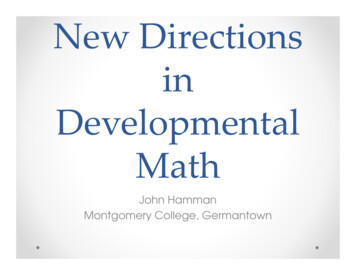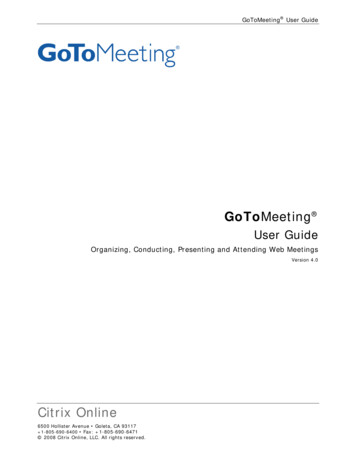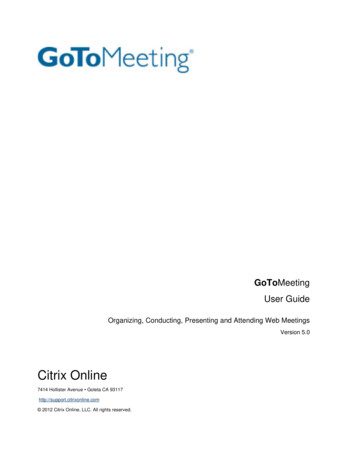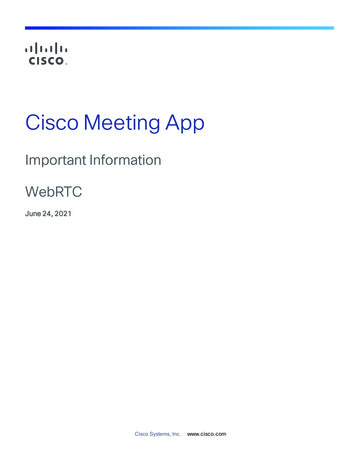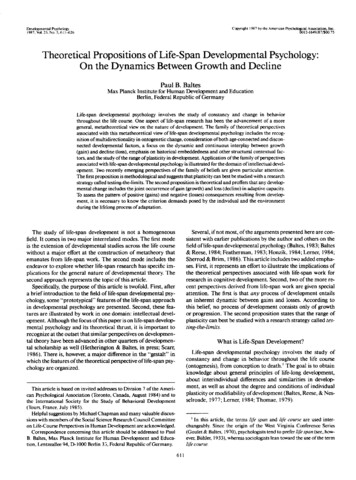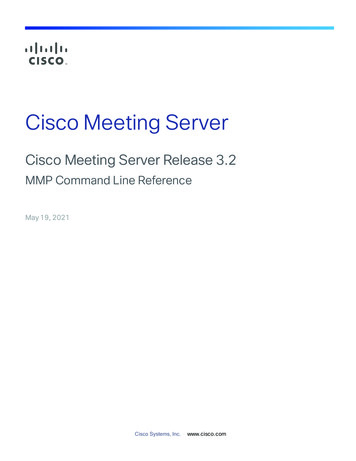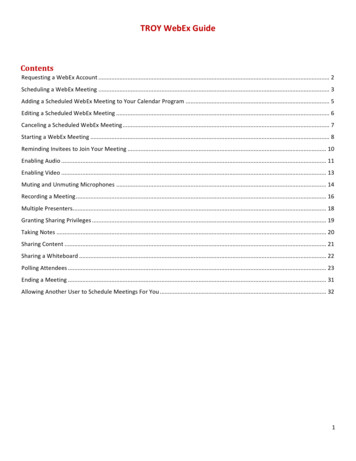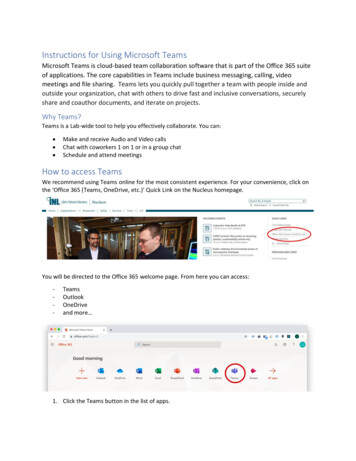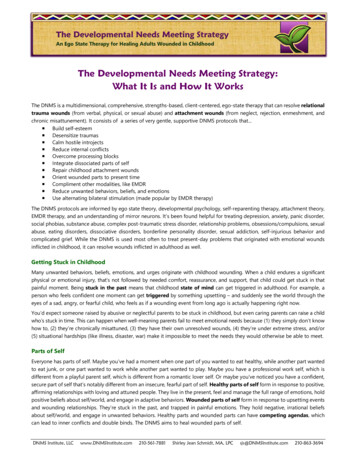
Transcription
DNMS: What it is and How it WorksPage 1 of 5The Developmental Needs Meeting Strategy:What It Is and How It WorksThe DNMS is a multidimensional, comprehensive, strengths-based, client-centered, ego-state therapy that can resolve relationaltrauma wounds (from verbal, physical, or sexual abuse) and attachment wounds (from neglect, rejection, enmeshment, andchronic misattunement). It consists of a series of very gentle, supportive DNMS protocols that. Build self-esteem Desensitize traumas Calm hostile introjects Reduce internal conflicts Overcome processing blocks Integrate dissociated parts of self Repair childhood attachment wounds Orient wounded parts to present time Compliment other modalities, like EMDR Reduce unwanted behaviors, beliefs, and emotions Use alternating bilateral stimulation (made popular by EMDR therapy)The DNMS protocols are informed by ego state theory, developmental psychology, self-reparenting therapy, attachment theory,EMDR therapy, and an understanding of mirror neurons. It’s been found helpful for treating depression, anxiety, panic disorder,social phobias, substance abuse, complex post-traumatic stress disorder, relationship problems, obsessions/compulsions, sexualabuse, eating disorders, dissociative disorders, borderline personality disorder, sexual addiction, self-injurious behavior andcomplicated grief. While the DNMS is used most often to treat present-day problems that originated with emotional woundsinflicted in childhood, it can resolve wounds inflicted in adulthood as well.Getting Stuck in ChildhoodMany unwanted behaviors, beliefs, emotions, and urges originate with childhood wounding. When a child endures a significantphysical or emotional injury, that’s not followed by needed comfort, reassurance, and support, that child could get stuck in thatpainful moment. Being stuck in the past means that childhood state of mind can get triggered in adulthood. For example, aperson who feels confident one moment can get triggered by something upsetting – and suddenly see the world through theeyes of a sad, angry, or fearful child, who feels as if a wounding event from long ago is actually happening right now.You’d expect someone raised by abusive or neglectful parents to be stuck in childhood, but even caring parents can raise a childwho’s stuck in time. This can happen when well-meaning parents fail to meet emotional needs because (1) they simply don’t knowhow to, (2) they’re chronically misattuned, (3) they have their own unresolved wounds, (4) they’re under extreme stress, and/or(5) situational hardships (like illness, disaster, war) make it impossible to meet the needs they would otherwise be able to meet.Parts of SelfEveryone has parts of self. Maybe you’ve had a moment when one part of you wanted to eat healthy, while another part wantedto eat junk, or one part wanted to work while another part wanted to play. Maybe you have a professional work self, which isdifferent from a playful parent self, which is different from a romantic lover self. Or maybe you’ve noticed you have a confident,secure part of self that’s notably different from an insecure, fearful part of self. Healthy parts of self form in response to positive,affirming relationships with loving and attuned people. They live in the present, feel and manage the full range of emotions, holdpositive beliefs about self/world, and engage in adaptive behaviors. Wounded parts of self form in response to upsetting eventsand wounding relationships. They’re stuck in the past, and trapped in painful emotions. They hold negative, irrational beliefsabout self/world, and engage in unwanted behaviors. Healthy parts and wounded parts can have competing agendas, whichcan lead to inner conflicts and double binds. The DNMS aims to heal wounded parts of self.DNMS Institute, LLCwww.DNMSInstitute.com210-561-7881Shirley Jean Schmidt, MA, LPCsjs@DNMSInstitute.com210-863-3694
DNMS: What it is and How it WorksPage 2 of 5DNMS Classification of Wounded Parts of SelfWounded parts that form in reaction to unmet safety and attachment needs are called reactive parts. There are three kinds.Powerless reactive parts hold raw emotions, like anxiety, terror, anger, sadness, hopelessness, grief, despair, and shame; holddetails of very painful experiences; and/or engage in “coping” behaviors such as withdrawing, overeating, starving, drinking,overachieving, etc. Controlling reactive parts are very mistrusting and often belligerent with the therapist. They often aim tosabotage therapy. Mimicking reactive parts deliberately, consciously, and willingly act like someone wounding, in order to“solve a problem.” They often intimidate other reactive parts to influence “safer” behaviors.All reactive parts have good intentions, no matter how many problems they create. They’re acting out the unwanted behaviors,beliefs, emotions, and urges that clients want therapy to fix – like depression, withdrawing, perfectionism, eating disorders,substance abuse, anxiety, anger, flashbacks, or intractable chronic inner conflicts, etc.Another kind of wounded part is the maladaptive introject. It’s a little harder to explain. First some background. Thanks tomirror neurons, our brains automatically and unconsciously record mental “movies” of both positive and negative experiences.It’s a biological reflex we have no control over. These recordings usually fade out, exerting no meaningful long-term influence.But when we’re physically or emotionally wounded by someone – in a significant way – a recording of it gets saved. This matters,because that recording can play back later, whenever a similar event triggers it. When this happens, the verbal or non-verbalmessage delivered by the wounding person plays back too – whether it’s a physically safety threat like, “I’m going to beat you,”or an emotional attachment wound, like “I hate you. You don’t matter.”When a recording conveying an upsetting message is activated, it can feel very real to reactive parts – evoking in them all thesame painful emotions they’d felt in the past, when the message was first conveyed. These painful emotions create the illusionthat the old wounding experience is still happening and still relevant right now. Every time these recordings play back, reactiveparts feel rewounded. They react with unwanted behaviors, beliefs, emotions, or urges – just like a powerless child would react.So what does this have to do with maladaptive introjects? Well,the DNMS assumes a child’s basic true nature is good – with anatural curiosity and eagerness to learn – and a desire to be inrespectful harmony with self and others. Caregiver messages (like“You matter”) that are aligned with that basic goodness, integrateseamlessly into the child’s personality and psyche. But woundingmessages that do not match a child’s basic goodness, cannotintegrate seamlessly – instead, they attach superficially to aninnocent part of self, like a mask or costume of the woundingperson. The part that’s stuck wearing it to does not like it, wantit, or need it, but cannot remove it (without help). This part of selfis called a maladaptive introject.Maladaptive Introject@#!&@Maladaptiveintroject maskI don’t likethis mask!Part of self wearingthe introject maskHealthy Parts of SelfHealthy parts of self form and strengthen with affirming, nurturing relationships. Many clients are not especially aware of theirhealthy parts, but it’s evident in way they may care for their pets, plants, patients, children, etc. These healthy parts of self canbecome loving caregivers for wounded parts – willing and able to meet their unmet emotional needs. In the DNMS, specialguided meditations are used to help a client connect to a team of three special healthy parts – also called Resources. Theyinclude a Nurturing Adult Self, and a Protective Adult Self, and a Spiritual Core Self (or Core Self),.The Nurturing & Protective Adult Self: Most people have all the skills needed to be a good enough caregiver, whetherthey are aware of it or not. A caregiver skill that was applied just once in the past can be applied again in the future. The DNMSDNMS Institute, LLCwww.DNMSInstitute.com210-561-7881Shirley Jean Schmidt, MA, LPCsjs@DNMSInstitute.com210-863-3694
DNMS: What it is and How it WorksPage 3 of 5uses two guided meditations to heighten awareness of these skills. One meditation strengthens a Nurturing Adult Self (a part ofself that can competently nurture a loved one), the other strengthens a Protective Adult Self (a part of self that can competentlyprotect a loved one). The meditations are anchored by a client’s personal, meaningful relationship with a child, pet, plants, orhelpless person. A remarkable experience – current or past – when all or most of the skills on a list of 24 caregiver skills andtraits were naturally, effortlessly, and appropriately applied.The Spiritual Core Self: Considered the core of one’s being. It’s a state of mind experienced during meditation, prayer, yoga,peak spiritual experiences, enlightening near-death experiences, and profound connections with nature – usually for just a fewminutes at a time. Some people believe this is a part of self that existed before the body arrived and will exist after the body dies.The following qualities, commonly experienced during deep prayer or meditation, are characteristic of the Spiritual Core Self. Sense of interconnectedness to all beings No desires or aversions Sense of completeness and wholeness Unconditional, effortless acceptance, loving kindness, compassion Sense of safety and invulnerability Timeless, cosmic wisdom and understanding No ego, no struggles Timelessness; present moment is precious and fullFor those of faith, this is the part of self that resonateswith divine love from a higher power. Connecting to thisResource does not require a belief in God or spirituality.Clients averse to notions of spirituality can be guided toconnect to a Core Self.Healing Circle: Once a client has established eachResource, all three are invited to come together as ateam, to form a Healing Circle. Later, wounded parts willbe invited inside the Circle, where the Resources willprovide the emotional repair necessary to help them gettotally unstuck.The Healing CircleSpiritual Core SelfNurturingAdult SelfProtectiveAdult SelfGetting Wounded Parts UnstuckThe DNMS has many interventions and protocols for getting wounded parts unstuck from the past. Connecting clients to aResource team is an important first step. Clients who are not ready to mobilize a complete Healing Circle can be guided toconnect to a team of Provisional Resources – which is usually easier and quicker to do.Phase 1: The healing starts by inviting forward the most upset reactive parts first. For example, a reactive part that got triggeredyesterday; a controlling reactive part trying to sabotage therapy; or any other parts the client is troubled by. Parts that comeforward are welcomed, validated, and invited to tell their story. The Resource team is invited to reassure and comfort them. Theirmisunderstandings are cleared, and any missing information is provided. Reactive parts are given as much time as they need toorient to present time, and to notice the safety of living in the present, in an adult body. If they feel as if they’re reliving an oldwounding experience, they’re guided to see they’re just reacting to a harmless recording of it. Additional rapport-buildinginterventions help transform controlling reactive parts from therapy saboteurs to therapy allies. All these interventions helpreactive parts get partly unstuck by bringing them into the present moment, where they feel safe and comforted. This significantlyreduces their reactivity. These interventions (and more) are covered in the DNMS webinar, Ego State Therapy Interventions toStabilize Your Most Wounded, Belligerent, and Dissociative Clients. http://www.dnmsinstitute.com/webinar0-infoPhase 2: Once reactive parts feel loved, safe, and stable with their Resource team, we apply the Conference Room Protocol.Reactive parts are invited to look across a conference table to see the wounding person they’re reacting to appear on the otherside. They’ll see something like a holographic video recording of the person (actually it’s a maladaptive introject costume). Thenthey’re skillfully guided to disclose the recording’s complete wounding message – whether it had been conveyed verbally, nonverbally, or both. When the complete message is written down, we zero in on the part of self unwillingly stuck wearing thecostume. A unique protocol, called Switching the Dominance is then applied. It’s a series of questions that help the part learnand understand that the costume is just a harmless recording. In the process, the costume transforms from something large,animated and threatening, to something insignificant, inanimate, and small enough for the part to pocket. (See illustration onpage 4.) This phase concludes with the introject part, and the reactive part across the table, feeling much less stuck - profoundlyshifting the client’s unwanted behaviors, beliefs, emotions, and urges around the targeted issue.DNMS Institute, LLCwww.DNMSInstitute.com210-561-7881Shirley Jean Schmidt, MA, LPCsjs@DNMSInstitute.com210-863-3694
DNMS: What it is and How it WorksPage 4 of 5Phase 3: The Needs Meeting Protocol completes the healing. Introjects and reactive parts that have completed Phases 1 and2 are invited into the Healing Circle. During Needs Meeting the Resources are guided to (1) meet all their unmet emotional needs– one need at a time, (2) help them process through all their painful emotions– one emotion at a time, and (3) strengthen aloving emotional bond. Needs meeting is complete when the wounded parts feel completely unstuck and want to go play, thecostumes are completely gone, the memory of the painful events and wounding messages evoke zero disturbance, negativebeliefs no longer feel true, the body is free of any disturbance, and the client looks happy. It’s very thorough and typically takes2-4 hours to complete. Parts healed during the Needs Meeting Protocol are totally unstuck, and cannot get triggered again.Repeat: These three phases are repeated for each issue a client wants to target. As more and more wounded parts are guidedthrough these protocols, the client becomes better at responding to stressful events with adult skills and strengths – withoutgetting triggered or overreacting.The Resource Development Protocol, all the Phase 2 and 3 protocols, and interventions for clearing blocks are described inthe DNMS book and the Home Study Course. http://www.dnmsinstitute.com/book http://www.dnmsinstitute.com/homestudySwitching the Dominance ProtocolDon’t crossme or I’llhurt you.I don’t likeHey. It’sthis mask!not so real.Now it hasno animationat all.I’m incharge now!DNMS Institute, ve, loving,attuned Resources“You’re okay”Unresolved DisturbanceConnectionDuring DNMSSee diagram on the right. Before the DNMS begins, woundedparts who are stuck in the past suffer from unresolved wounds.They’re relatively disconnected from Resource parts of self. Whentriggered, they feel powerless. During the DNMS, they make ahealing connection with loving, attuned Resources who aregrounded in the present. As the Resources meet their unmetneeds, those important neural pathways are strengthened. Whenall the needs are met, the wounded parts become totally unstuckand join the Resources in the present. Neural integration with theResources is complete. After DNMS therapy, clients report feelingmore integrated and whole, and better able to manage theiremotions.Isolatedchild partstuck in the past“I’m bad”Isolatedchild partstuck in the past“I’m bad”NewNeuralPathwayMature,sensitive, loving,attuned Resources“You’re okay”Disturbance ResolvingIntegratedchild part“I’m okay”ConnectionAfter DNMSLoving, attuned caregivers will positively support a child to play,explore, socialize, individuate, and mature in healthy ways. Overtime, the child’s brain develops the neural pathways needed forthe self-regulation of emotions. If a child is not supported toengage in healthy, age-appropriate play, exploration, socialization,and individuation, these neural pathways may not form wellenough. The child will grow up feeling insecure, and in adulthoodwill have trouble relating to others and managing painful emotions.DNMS therapy appears to support the adult brain’s developmentof the important neural pathways needed for the self-regulationof emotion.DisconnectionBefore DNMSThe DNMS Leads to Neural IntegrationMature,sensitive, loving,attuned Resources“You’re okay”Totally Unstuck Disturbance ResolvedShirley Jean Schmidt, MA, LPCsjs@DNMSInstitute.com210-863-3694
DNMS: What it is and How it WorksPage 5 of 5What Makes the DNMS Different?A client’s childhood wounding could come from bad things that happened, important good things that didn’t happen, orboth. Trauma comes from bad things that happened, whether non-relational, like injuries from earthquakes, hurricanes, oraccidents, or relational, like physical or sexual abuse. Attachment wounding comes from good things that didn’t happen, likeinsufficient nurturing, validation, encouragement, reassurance, attunement, or someone to securely attach to. Consider that allemotional wounding from childhood that persists in adulthood, is connected to unmet emotional needs.The standard of care for treating childhood wounds is the trauma-treatment model – a three-stage approach including arapport-building/stabilization stage, a trauma-desensitization stage, and an integration/resolution stage. It’s based on theassumption that clients’ unwanted behaviors, beliefs, and emotions originate with trauma, and that stabilization followed bytrauma desensitization or reprocessing of the bad thing that happened, will lead to the desired change. This model is popularbecause it can work well for many clients. Unfortunately, the focus on traumatic events can be emotionally taxing, even afterpreparatory stabilization. But more importantly, it may not be especially helpful if a client’s insecurity has less to do with specifictraumatic events and more to do with attachment wounding.So instead of focusing on reprocessing trauma, the DNMS focuses on meeting unmet emotional needs. This is accomplished aswounded parts make a loving, healing connection to a team of robust inner Resources. This approach can successfully heal anykind of wounding inflicted by a person – whether wounds are minor, moderate, or severe; intentional or unintentional; physical oremotional; from acts of omission or commission. And because the healing work is a love-fest focused on meeting needs, notprocessing trauma, it’s always gentle and nurturing, with minimal risk of emotional overwhelm or retraumatization.Primary Agent for ChangeMany therapy models emphasize the importance of the client-therapist therapeutic alliance in healing attachment wounds. Theysuggest a therapist can provide enough corrective emotional experiences over time, just by listening with compassion andempathy, and modeling unconditional acceptance and understanding. While this may work with some clients, it puts a bigburden on the therapist. During the DNMS, a therapist’s attunement to a client is very important, but once a client has gottenpast the rapport-building stage, the primary agent for change is not a therapeutic alliance with the therapist, but the loving,supportive, stabilizing relationship wounded parts have with the Resources. This shifts the responsibility of meeting unmetemotional needs from the therapist, to the client’s own inner Resources.In ConclusionThe DNMS offers hope to therapists looking for a comprehensive, gentle, structured path to help clients resolve complex traumaand attachment wounds. It offers “talk therapy” clinicians a tool for deeper processing, and “trauma-treatment” clinicians a toolfor safer processing.About the DNMS DeveloperShirley Jean Schmidt, MA is an LPC in San Antonio, TX. She's the founder of the DNMS Instituteand author of The Developmental Needs Meeting Strategy: An Ego State Therapy for HealingAdults With Childhood Trauma and Attachment Wounds. She's trained hundreds of cliniciansin the DNMS model at regional, national, and international workshops and conferences since2002. She moderates an 800-member DNMS professional listserv. She is a past president of theSan Antonio Trauma & Dissociation Professional Study Group. For 6 years she was an EMDRIAApproved EMDR Consultant. She has published many articles about EMDR, ego state therapy,pain management, and the DNMS. She holds the patent on the TheraTapper , a bilateral tactilestimulation device that has been sold world-wide to DNMS and EMDR therapists.Published ResearchThere are currently two published, peer-reviewed journal research articles about the DNMS. The first is the DevelopmentalNeeds Meeting Strategy: A New Treatment Approach Applied to Dissociative Identity Disorder, published in the Journal ofTrauma and Dissociation in December 2004. The second is the Developmental Needs Meeting Strategy: Eight Case Studies.Published in Traumatology in March 2007. Both articles are posted at www.dnmsinstitute.com.DNMS Institute, LLCwww.DNMSInstitute.com210-561-7881Shirley Jean Schmidt, MA, LPCsjs@DNMSInstitute.com210-863-3694
The Developmental Needs Meeting Strategy: What It Is and How It Works The DNMS is a multidimensional, comprehensive, strengths-based, client-centered, ego-state therapy that can resolve relational trauma wounds (from verbal, physical, or sexual abuse) and attachment wounds (from ne

